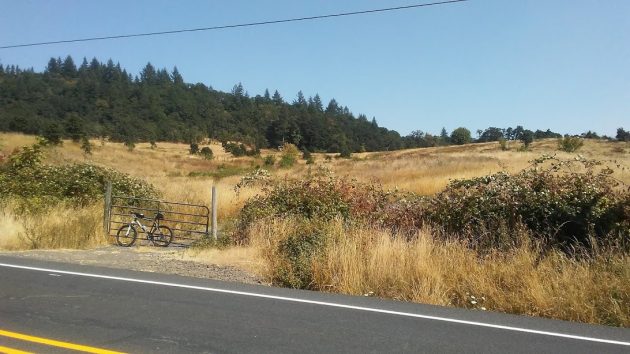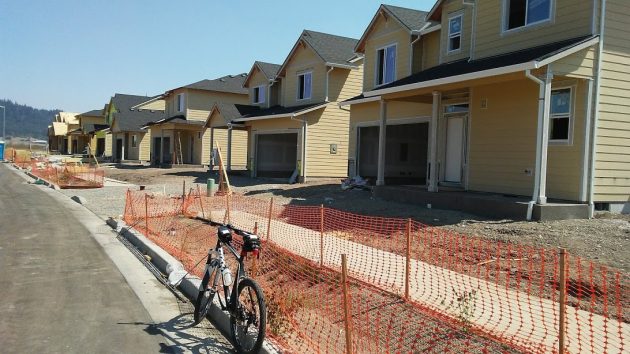
A Sunday bike ride took me past this hillside on the east side of Scravel Hill Road. Its owners would like to develop spacious home sites there, but a great thicket of city of Albany and Linn County land use regulations stand in the way, so far.
The development of the 34-acre site proposed by The Conser Group, an Albany real estate firm, envisions 37 lots averaging three-quarters of an acre each, arranged around a circular drive. The subdivision would have its own water and sewer systems constructed to municipal standards and governed by state regulations.
The problem? The land is outside the Albany city limits but inside the city’s urban growth area, an area called the “urban fringe.” It can be developed only if the county grants variances and conditional use permits, and only if Albany does not object to those permits.
Matt Conser and others of the development group have asked the city to raise no objections when they pursue their proposal with the county. But the city staff contends — in 16 pages of single-spaced text presented to the city council Monday — that the proposal is inconsistent with Albany plans, standards, and development rules. So, the city staff is against it, but whether to object is up to the council.
Mayor Sharon Konopa was outspoken against the Conser plan Monday, but the council did not reach a decision, though a majority seemed to be at least open to the development concept. Members suggested that the Consers come back with a response to the city staff’s objections.
If you’re up to an hour or so of land-use talk, you can listen to the discussion here. (The audio is of poor quality, though. It is marred by a lot of desktop noise, not to mention a failure to identify the speakers.)
In general, the staff objections were that this sort of development amounted to “sprawl,” with all the evils that the term implies. But when you look at the tightly-packed subdivisions that Albany zoning has encouraged on the flat farmlands inside the city, you’d think that bigger lots on an otherwise fallow hillside would make for a much more pleasant way to live. (hh)

On Sagecrest Drive N.E., this is the kind of close-together housing that Albany city zoning favors.

Oh that it would be as simple as you make it out to imply…
The specifics as to why city staff does not support the proposal can be found here (pages 2-19):
https://www.cityofalbany.net/images/stories/citycouncil/archive/2018/ws_20180820_agd.pdf
Hopefully the City Council can look back and find the information about the health hazard annexation of N. Albany and Drapersville when their septic tanks started failing. Much of Drapersville along Century Dr, was 2 acre lots and they still had failing tanks etc. and the city ended up annexing down Knox Butte to Marilyn and Charlotte streets as well as Century Dr.. Subdivisions don’t belong in the county, they belong in the city. Should the city pay for fire protection and a subdivision outside of the city needing the same services but only paying county rates be allowed. There are lots of reasons this development shouldn’t be allowed until city services can be extended and we aren’t later on wishing it had waited.
This land is in the urban growth boundary but is unlikely ever to be annexed because since the boundary was established, wetlands have been designated between this area and the city limits. The comparison to Draperville is not apt, I think. This proposal would have community water, wastewater and storm water systems, not individual wells or septic tanks. As for fire service, the owners there would pay about the same rate as owners inside the city through their rural fire district taxes.
Wetlands don’t stop development always. Unless they are major wetlands they can be mitigated by buying wetland credits. Over the years many wetlands have been developed. Look at recent park which had wetlands you talked about recently. There is a large development going in south of the Knox Butte traffic circle with large wetlands and they are still building and they also have a large gas line to work around. I think it was over a hundred lots.
I don’t believe the fire rate for rural areas is the same as the city rate which is about $2,00 per thousand if I understand right. It seems you are in favor of the building. Remember some of NA had their own water system and some were in really bad repair.
The real issue is development outside the urban service limits. OK they build their own water and sewer systems. Why? Because they can then stay outside the city limits and not have taxes go to the city.
Will they drive into the city to shop? Hell yes they will, but they won’t have to help pay for the wear and tear on the city streets they cause.
Will their property values rise? Hell yes they will, but the City they depend on won’t benefit, and EVERYONE else in the city will have to pick up their share of the costs they cause.
It’s a con game folks. And you are the Marks. If they really want to develop, then just petition for annexation and PAY YOUR FAIR SHARE.
Rich people will con you every way they can. Don’t fall for it.
Based on the condition of the streets within the city limits, it’s not clear that anyone’s taxes (within or without the city) are paying for maintenance. Was this not the reason the council has proposed a local gas tax?
Many reconstruction projects have been funded by bonds paid by property tax. Live outside the city, you don’t pay.
In another life I worked for a couple of decades in the drinking water/wastewater industry, primarily in small rural communities. During that time, I witnessed the outcome of hundreds of this sort of little private utility developments, and the outcome was NEVER good. Eventually, some City or County ends up having to absorb the burden of taking over and fixing the problems. Might be in ten years or fifty, but Albany will eventually get to deal with (and pay for) this development. Very poor planning.
Hey….wait a minute. Just cuz the Conser proposal doesn’t do anything to improve the Downtown Albany area doesn’t mean it shouldn’t be considered. Perhaps the Conser Group could build some subsidized housing and get all those smelly, crazy homeless folks out of the CARA Gilded Zone between 1st and 4th streets. Then, the Downtown Association, the Chamber of Commerce and the City Council could move ahead with more planning to Make Albany Great Again.